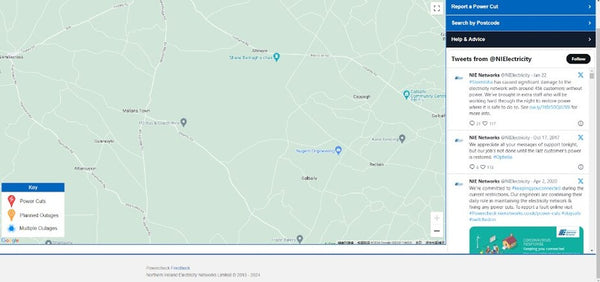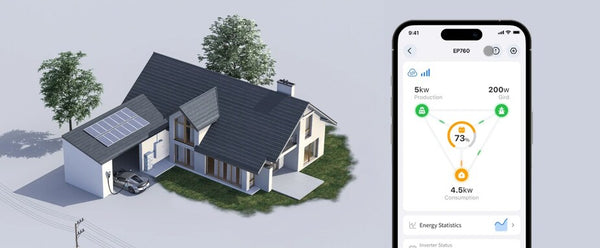Power outages can be unexpected and inconvenient in any city, disrupting daily life and routines. Belfast, the vibrant capital of Northern Ireland, is no exception to such unforeseen events. In this comprehensive article, we delve into the issue of Belfast power cut, exploring the causes and duration and, most importantly, guiding readers on what to do when faced with a power outage.
Is there a Power Cut in Belfast?
The first step in dealing with a power outage is determining whether it's a localized or widespread blackout affecting the entire city. Luckily, residents of Belfast can easily access real-time information about power cuts by visiting the official website of Northern Ireland Electricity Networks (NIE Networks).
The PowerCheck tool, available at https://powercheck.nienetworks.co.uk/, provides up-to-date information on power supply status across different regions in Belfast.

Navigating the website, users can input their postcode or browse the map to check the current status of electricity in their area. The tool informs users about ongoing power cuts and offers estimated restoration times, allowing residents to plan accordingly.
What to Do in a Power Cut in Belfast?
Experiencing a power cut can be challenging, but being prepared and knowing what to do can make the difference between a minor inconvenience and a more manageable experience. Here's a comprehensive guide on what to do during a Belfast power cut:
Stay Calm and Informed:
The first and foremost step is to remain calm. Power cuts are often temporary, and utility providers work diligently to restore electricity promptly. Check the official NIE Networks PowerCheck tool at https://powercheck.nienetworks.co.uk/ to get real-time information about power status in your area. This tool provides updates on ongoing outages and estimated restoration times.
Report the Outage:
Contact NIE Networks to report the power outage in your area. You can call their emergency helpline or write the issue through their website. Provide essential information, such as your location and any details that might help identify the cause of the power cut.
Conserve Battery Power:
Preserve the battery life of your electronic devices, such as smartphones and laptops. Minimize their use in essential communications. Consider fully charging portable chargers or power banks to keep your devices operational during the outage.
The good thing is that you can still use your phones and laptops and other home appliances with BLUETTI EP760. It can be connected to your home power grid, and when a power outage is detected, the battery can be immediately switched to power your home.

Use Backup Lighting:
Have flashlights, candles, or battery-powered lanterns readily available. These can provide necessary illumination without relying on the power grid. Please exercise caution when using candles to prevent accidents, and never leave them unattended.
Keep Refrigerator Closed:
Avoid opening the refrigerator or freezer unnecessarily. A closed refrigerator can maintain a lower temperature for longer, preserving perishable food items. Consider having a cooler with ice packs for storing essential items if the power cut is expected to be prolonged.
Stay Informed about Restoration Times:
Regularly check the PowerCheck tool for updates on estimated restoration times. This information can help you plan your activities and manage resources effectively. Listen to battery-powered radios for updates and important announcements from local authorities.
Prepare for Medical Needs:
If you or anyone in your household relies on electricity-powered medical devices, ensure you have a plan. It may involve having backup power options or relocating to a facility with electricity if necessary.
Secure Your Home:
Ensure all electrical appliances are turned off to prevent damage or electrical surges when power is restored. If you plan to use a generator, follow safety guidelines and place it in a well-ventilated area to avoid carbon monoxide buildup.
Community Support:
Check on your neighbors, especially older people or those with special needs. Community support can be crucial during power outages. Share information about the power cut and encourage others to stay informed through official channels.
Plan for Entertainment:
Have board games, books, or other non-electronic forms of entertainment on hand to pass the time during a power cut. Engage in activities that don't rely on electricity to keep yourself and your family occupied.
By following these steps and staying informed, you can navigate a power cut in Belfast with resilience and preparedness. Remember that power restoration efforts are underway, and normalcy will return soon.
What Causes the Power Cut in Belfast?
Like in any other city, power cuts in Belfast can be caused by various factors. Understanding these causes is essential for residents and utility providers to implement preventive measures and respond effectively. Here are some common reasons for Belfast power cut:
Weather-Related Issues:
Storms: Severe storms, including strong winds, heavy rain, or snowfall, can lead to power outages. Falling trees or branches can damage power lines and other electrical infrastructure, disrupting the supply.
Lightning Strikes: Lightning can directly strike power lines, transformers, or other electrical equipment, causing extensive damage and triggering power cuts.
Equipment Failures:
Transformer Failures: Transformers are critical components in the power distribution system. Failures due to age, wear and tear, or manufacturing defects can lead to power outages.
Circuit Breaker Malfunctions: Circuit breakers are designed to interrupt the flow of electricity in case of faults. Malfunctions in these devices can lead to power cuts.
Human Error:
Construction or Maintenance Accidents: Accidents during construction or maintenance work near power lines can result in power outages. Human error, such as incorrectly performed maintenance procedures, can also contribute to disruptions.
Overloading of the Grid:
Peak Demand: During periods of high electricity demand, such as extreme weather conditions or special events, the electrical grid can become overloaded. It may lead to automatic shutdowns to prevent system damage.
Animal Interference:
Contact with Power Lines: Animals coming into contact with power lines or entering substations can cause short circuits, leading to power cuts. Squirrels and birds are common culprits.
Cybersecurity Threats:
Cyberattacks: The power grid is susceptible to cybersecurity threats in the digital age. Malicious actors may attempt to disrupt the grid by hacking into control systems or other critical infrastructure.
Substation Failures:
Substation Equipment Issues: Substations play a crucial role in power distribution. Failures or malfunctions in substation equipment can lead to widespread power outages.
Grid Instability:
Voltage Fluctuations: Unstable voltage levels in the grid can trigger protective measures, causing power cuts to prevent damage to electronic devices and appliances.
Natural Disasters:
Earthquakes or Floods: Natural disasters like earthquakes or floods can damage power infrastructure, leading to widespread power outages.
Supply Chain Disruptions:
Fuel Shortages: In some cases, power plants may experience fuel shortages, impacting their ability to generate electricity and resulting in power cuts.
How Long Will the Power Cut Last?
One of the most pressing concerns during a power outage is the duration of the disruption. Unfortunately, predicting the exact duration of a power cut can be challenging, as it depends on various factors, including the cause of the outage, the extent of the damage, and the availability of resources for repairs.
Utility providers like NIE Networks work tirelessly to restore power quickly. The PowerCheck tool mentioned earlier provides users with estimated restoration times based on ongoing assessments by the utility company. It is essential to regularly check for updates on the tool to stay informed about the progress of restoration efforts.
While some power outages may be resolved within a few hours, others, especially those caused by severe weather events or extensive infrastructure damage, may take longer to address. Residents should be prepared for an extended outage and take necessary precautions, such as utilizing backup power sources like generators or solar-powered systems.
Conclusion:
Power cuts in Belfast are an occasional inconvenience that residents may face due to various factors such as weather-related issues, equipment failures, human error, grid overload, animal interference, and cybersecurity threats. The key to navigating such situations is staying calm, informed, and prepared.
The PowerCheck tool provided by NIE Networks offers residents a valuable resource to stay updated on the status of power outages and estimated restoration times. Additionally, investing in reliable backup power solutions like the BLUETTI EP760 can ensure that essential functions are maintained during an outage.



